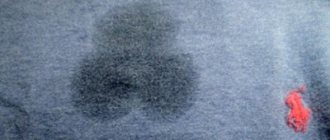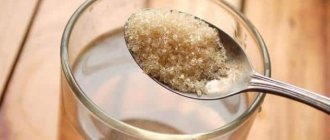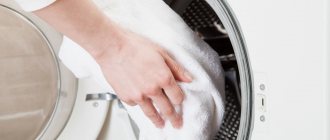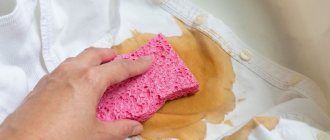The material bitumen is used in construction, repair and construction of roads. Contamination of clothing and shoes with it occurs in the hot summer, when the asphalt melts and if you walk on it, it clings to the sole and sides of the shoe. Its particles fly from under the wheels of cars and stick to our things.
If you see a tarry substance on your clothes, you need to immediately clean it, because over time it will cut into the fabric or skin even more strongly. It is important to know that bitumen cannot be washed; it does not dissolve in water and simply spreads across the fabric. It is impossible to remove it by combing, because the surface of the material can be damaged.
If your clothes are heavily soiled with it, you should try to remove it with your hands or scrape it off with a knife. Freezing the item helps some, while heating it for others helps. Sometimes bitumen freezes and becomes so attached to the threads of the fabric that it is impossible to clean it. After freezing, bitumen becomes brittle, easily breaks into pieces and comes off clothes.
After mechanical removal of bitumen parts, we proceed to chemical cleaning with gasoline, white spirit, kerosene or acetone-based solvent. Gasoline is better than acetone for removing bitumen stains. Apply a soap solution around the stain to prevent it from expanding. The solvent is applied to a cotton pad and applied to the fabric for 2-3 seconds and the bitumen is wiped off the clothing. After this, the item is washed following the instructions listed by the manufacturer on the label. Do not leave the solvent on clothes for longer, so as not to harm the fabric.
Methods for removing bitumen stains
In order to remove traces of bitumen, you can choose professional or folk remedies.
We must not forget that it is better to remove mastic immediately after contamination, so the availability of a cleaner plays a big role. It is equally important to consider what material the soiled item is made of, since different products are suitable for different fabrics
Professional products
Bitumen removers are often intended for motorists and are ideal for removing stains from car paint and chrome elements. The advantage of cleaners is that they remove bitumen stains without damaging the base. As a rule, they are produced in the form of convenient cans. The product is sprayed onto the stained area, wait a while, and wipe off any remaining dirt. Professional aerosols are also suitable for removing bitumen from clothes.
Super DeGreaser
The cleaner will effectively remove bitumen drops not only on car body parts, but also on fabric. It is easier to remove dirt from natural materials such as cotton and calico, as well as from the denim from which jeans are made. The product is applied to the stained area for 5 minutes, after softening, the mastic is removed with a cloth or cotton swab and the item is washed with detergent.
Tar Remover
The product will help remove oil and bitumen stains, as well as remove stubborn dirt. Apply to the affected area for a few minutes and wash off after exposure. If the bitumen layer is thick or the stain is old, repeated treatment may be required. After removing the dirt from the fabric, wash it in the usual way.
"Eltrans"
Eltrans bitumen stain cleaner is available in aerosol form and is intended to remove traces of bitumen, tar, and technical fluids from car parts, but is also used for other surfaces. To clean the dirt, shake the can and spray the product onto the area, leave for 5-10 minutes, then clean with a sponge.
How to use
Before using professional cleaning products, you must protect your hands with gloves. It is advisable to test the effect of the substance in an inconspicuous area so as not to spoil the item. When using the products, you should carefully study the instructions on the packaging and follow them.
Self-preparation of the solution
To eliminate bitumen contaminants, you can prepare a mixture of starch, turpentine and white clay, taken in equal parts, one teaspoon of each component is enough. The solution is thoroughly mixed to a paste-like state, adding a few drops of ammonia, and applied to the stain. After the mixture has dried, it is removed with a brush, and the item is washed by hand or in a machine. A yellowish mark may be visible on the affected area, in which case it should be wiped with hydrogen peroxide.
Traditional methods
You should try to remove bitumen as soon as possible, before it has time to eat into the fabric, and if there are no professional cleaners at hand, you can resort to the help of improvised properties. They are also useful for removing dirt from materials that will not withstand exposure to solvents, such as synthetic fabrics.
Butter
A little butter is rubbed into the bitumen stain. The contaminated area becomes lighter, while the oil turns black. Rub the stained fabric with oil until the bitumen completely disappears. Then the item is washed with detergent.
Fir oil
The product is well suited for removing bitumen from fabrics, even delicate ones. To do this, two cotton pads are soaked in oil and pressed against the material on both sides. After the stain has been removed, the item must be washed to remove the greasy traces of fir oil.
Coca Cola
Coca-Cola is added to the water along with detergent and the item is washed as usual. The stain disappears during the washing process.
Soda solution
Baking soda helps remove many types of dirt, including bitumen. To clean soiled clothes, dissolve 30 grams of caustic soda in a liter of water and soak the clothes in the product for a couple of hours. Afterwards the item needs to be washed and rinsed well.
Cleaning synthetic materials
When we start cleaning clothes from bitumen from synthetic materials, there is a high risk of them being damaged or even disappearing from contact with solvents. These products, together with bitumen, also destroy fabric. Perhaps such actions will have to be abandoned.
You can start by removing bitumen particles by hand. Next, try using purified kerosene or BR-2 gasoline solvent, which can be purchased at automotive stores. They do not have such an aggressive effect on the fabric. On artificial fibers, it is advisable to test all solvents before using them on inconspicuous areas of the item to find out the degree of their impact. Solvent 647 or 646 is considered not a very strong agent.
After destroying the stain, you should immediately wash it, adhering to the temperature regime. To improve the quality of washing, you can add stain remover powder or Vanish.
Among the effective methods, some are also used for natural fabrics. For example, manipulations with butter.
Wash carefully following the manufacturer's recommendations on the clothing label.
How to remove bitumen stains from a car
On cars, splashes and drops of bitumen resins appear on the lower parts of the wings, arches and front bumpers (a gift from the vehicle driving ahead). Undesirable resinous tuning is revealed when it has already petrified and become as durable as a metal tile corner, except that it shines less.
Bitumen is resistant to water of any temperature and most water-containing solvents. They are easily removed by benzene, carbon disulfide and other organic solvents - turpentine, white spirit, etc. Before removing bitumen stains from a car, you need to make sure that the car enamel is resistant to the selected solvent. It is best to buy special “Bitumen stain cleaner” or Profam 3000, but be sure to buy branded bottles. These compounds do not leave marks on the varnished surface of the wings and on the chrome hoods.
If a special cleaner is not available, use kerosene or diesel fuel to remove bitumen from your car; they do not interact as actively with car enamel as standard gasoline. Small and rare bitumen splashes can be removed with ordinary butter if you are patient. The place where the bitumen stain was located will need to be polished, otherwise its shade will be discordant with the main color of the car paint.
Photo - how to remove bitumen stains from a car, zarmon.net
Photo of the car in bitumen, zarmon.net
Photo of removing bitumen stains from a car, zarmon.net
Photo of means for removing bitumen from cars, zarmon.net
Photo of bitumen, zarmon.net
How and with what to scrub, clean, and remove fuel oil from sneakers?
If your sneakers are made of fabric, and your shoes are made of polyurethane or phylon, then they can be washed in an automatic machine. Just don’t immediately throw shoes with fuel oil stains into the drum of the machine. First, measures should be taken to clean these stains (with dishwashing liquid, gasoline, solvent, etc.), and only then wash them.
Do not use laundry detergent, especially one that has bleaching properties, if your sneakers are not white. It is better to use gel or liquid for washing.
Do not turn on the spin or dry mode when washing sneakers or sneakers. Let the shoes dry naturally.
Sneakers with mesh are best washed by hand. The mesh is a very fragile material - it can tear into pieces.
Removing fuel oil stains from sneakers
How can you remove bitumen from shoes?
If the products are not made of fabric, then all of the listed types of solvents can be tested on them, starting from the softest and moving on to more aggressive ones. It should be remembered that genuine leather tolerates such cleaning better than a substitute. But in the case of suede, everything is quite complicated. Even if the stain can be completely removed, the shoe will most likely have to be completely repainted black.
If bitumen has to be removed from a carpet or floor covering, a wide variety of solvents are again used. Unfortunately, such manipulations often lead to permanent changes in the color and texture of the material.
Preparation
To remove resin stains faster and more effectively, things need to be prepared. The structure of resinous substances is quite complex, so it is not possible to simply wash them off.
Main stages of preparation:
- If the stain is convex, that is, there is quite a lot of resin, then first try removing it mechanically. Use a sharp object for this, for example a nail file, blade or knife. But be extremely careful, otherwise you will damage the fabric and simply ruin the item. In addition, you only need to remove that part of the resin that rises above the material, that is, that has not become embedded in the fibers.
- Next, place the product in the freezer compartment of your refrigerator. Frozen particles will easily separate from the fabric, and only that part of the resin will remain that has already become embedded in the material and penetrated through the fibers.
After such manipulations, you can proceed to further actions.
Cotton and linen
If you need to wash tar from thick cotton clothes, this recipe will help: mix turpentine, white clay and starch taken in equal parts. Apply to the contaminated area and wait until a crust forms, then clean off with a stiff brush.
How else can you clean tar if it gets on cotton or linen? Gasoline will help in this matter. It is used like this: a fabric with a stain is stretched over an empty container, spilled with gasoline, left for 2 - 3 hours, rinsed, washed with powder.
Treatment with solvents gives good results, and natural fabrics can withstand both petroleum-based solvents and acetone, although the latter copes worse with fuel oil, tar and bitumen.
What should you do first to remove a stain?
Fresh, small stains of resin that have not had time to dry are much easier to remove. If you act quickly, the likelihood of eliminating contamination without a trace increases.
When the resin just gets on clothing, skin or another surface, you must try to immediately remove as much of the adhesive mass as possible .
This must be done very carefully, without spreading the stain over an even larger area. It is convenient to use a napkin or rag for this purpose.
The thick mass, while it is fresh, can be lifted with a scraper or a regular spoon. After most of the resin has been removed, a residue may remain on clothing or other items.
Before proceeding with further processing, the soiled item must be prepared - remove dust and dirt . You also need to decide which product is suitable for dealing with stains based on the type of resin and type of material.
We clean stains with improvised means
You put one stain on your clothes by accident, and you don’t want to buy a whole package of ready-made product because of one such mark on your clothes? Then you can try to remove the contamination with home remedies. We will tell you how to remove such marks.
If the item is made of linen or cotton fabric, first try to wash the stain this way: wipe it with a swab or cotton pad soaked in ammonia.
- Regular butter is quite effective in removing tar stains. Apply a small amount of it to the area where there is a trace of tar, and gently wipe the stain with a sponge or clean rag. Do this until it disappears completely. The oil will darken over time and the stain will disappear. Then the item can be washed as usual.
- Sunflower oil and fir oil can help solve this problem. To do this, apply a small amount of this oil to a cotton pad and gently wipe off the stain. This must be done on both sides of the product with wiping movements in one direction. Then we remove the remaining greasy stains from the clothes. They simply wash with dishwashing detergent. Treat oil stains with this product, rub, leave for half an hour and wash the product.
- You can remove tar stains from clothes in another very unusual, but very effective way. Just add about 1 cup of Coca-Cola to the powder during washing - the tar washes out perfectly. It sounds strange, but it always helps. True, this method is only suitable if the stain is small and completely fresh.
- You can easily remove such stains with caustic soda. Take 1 glass of this soda, dilute it in approximately 10 liters of warm water. Leave the item in the bowl with this solution for 1-2 hours, then wash.
- You can remove the stain with a mixture of soda, turpentine, starch and ammonia. All components, except alcohol, are mixed in a glass container in equal proportions, so much alcohol is added so that the mixture has a consistency similar to thick sour cream. Apply the resulting mixture to the contaminated area and leave to dry completely. Remove any remaining mixture and wash the item.
If there are a lot of such stains on the clothes, for example, if the clothes are work clothes, then the item is left for two to three hours in gasoline, then wrung out, rinsed several times in running water and washed in the machine in an accessible mode. Gasoline must be purified!
How to get rid of resin based on fabric type
Just throwing the item in the washing machine is not an option. This will not help wash it completely. In order not to spoil it, study the inside label and check the composition of the material.
| Type of textile | How to remove a stain |
| Jeans | Ammonia |
| Cotton | Acetone |
| Natural wool | Dishwashing gel |
| Synthetics | Antibacterial hand gel |
| Suede, velvet | Vodka |
Resin can be easily removed from natural or artificial leather with vegetable oil. Dampen a small piece of cotton wool and carefully peel it off. Then wipe with a cloth soaked in a mild soap solution.
To remove resin from fur, use butter, sunflower or olive oil. Soak a cotton pad and apply for 40 minutes. Wash off any leftovers.
The main rule for removing bitumen stains
The key to successfully combating any pollution is understanding its nature. Therefore, before deciding how to wash bitumen, you need to figure out what kind of substance it is. So, bitumen is a product of oil distillation, or, quite simply, that part of the oil that remains after removing light fractions from it. Accordingly, only substances obtained by petroleum distillation can dissolve it.
Conventional chemical solvents based on acetone will not cope with bitumen due to the inappropriate chemical composition. The basis of oil and any products derived from it are high-molecular carbohydrates. And acetone contains oxygen groups that prevent the product from breaking down these same carbohydrates. So, with the help of acetone-containing solvents, you can, at best, slightly lighten the bitumen stain, and at worst, spread it over an even larger area of the stained item.
What not to wash bitumen from clothes and shoes
On many household forums you can find advice on removing bitumen stains using improvised means. Nail polish remover, ethyl alcohol, and even Coca-Cola are offered. If you carefully read the previous section, then you already understand that such “solvents” will be of no use.
Cleaning products are also offered by hardware/construction/automotive stores. Most often it is recommended to use WD-40, which is used as a water repellent and lubricant. Due to the presence of white spirit in the composition, this product dissolves bitumen stains relatively well. But, since mineral oil is present in large quantities among the components of WD-40, it is still not worth using it to clean clothes. The oil will quickly be absorbed into the fabric, and you will have to additionally remove the grease stain. But if you are looking for something to wash bitumen from leather or leatherette shoes, this composition is quite suitable. For fabric, it is better to use pure white spirit.
How to clean a bitumen stain: step-by-step instructions
Bitumen contamination rarely looks like an ordinary stain. Most often it is a patch of thick viscous resin. Therefore, the first cleaning step is to remove as much bitumen as possible mechanically.
First, cut off the thick layer of bitumen with a sharp knife. A stationery or breadboard knife is best; you can also use a regular razor blade.
Be careful not to damage the fabric fibers/leather surface to which the mastic is stuck.
There is no need to scrape off the bitumen coating. Firstly, you have a high chance of simply smearing it over the base, thereby increasing the area of the stain. Secondly, if the bitumen has already adhered well to the surface, the blotch can tear a piece of fabric out of it. It is especially dangerous to scrape off mastic from patent leather shoes - damage to the varnish is almost inevitable.
Sometimes, to make cutting bitumen easier, it is advised to place the item stained with it in the freezer for a while. It is assumed that a drop of bitumen, like chewing gum, will freeze and fall away from the fabric. In practice, this results in the mastic being absorbed even more strongly into the base, and it becomes almost impossible to remove it.
When the bulk of the bitumen has been removed, roll up a roll of scrap cotton rag and place it under the stain. Make sure that the soiled fabric is tightly stretched over the roller. Then start dripping the solvent of your choice onto the stain - gasoline, kerosene, etc. The bitumen will dissolve and be absorbed into the substrate. Whenever it gets dirty, turn the roller over to the clean side.
Continue these procedures until the stain disappears. Then wash the item with a good stain remover (Vanish has collected the most flattering recommendations for this case). If yellowish stains remain on the fabric, remove them with hydrogen peroxide.
Harmful products
In addition to effective means, there are those that can cause damage to things and shoes. For example, it is recommended to use WD-40 aerosol, which is applied to the stain and after a few minutes is removed with a soft cloth. It is recommended because of the white spirit it contains. It really helps, but it contains mineral oil, which can create new stains and you will also have to get rid of them.
Although nail polish remover contains acetone, it contains isopropyl alcohol, which makes it difficult to dissolve and remove bitumen mastic.
Using Coca-Cola in cleaning bitumen will not be beneficial. He is beyond her power.
What not to use to remove bitumen stains
Bitumen cannot be washed with ordinary water. Washing can only help with fresh stains, but be sure to add an oxygen stain remover or pre-soak the item in a previously prepared composition.
You should not freeze an item that is stained with tar. This resin strongly eats into the fibers, after which it is quite difficult to remove and not always successful.
If a synthetic or silk item is contaminated, it is not recommended to use strong solvents, as the material may come apart. If only such means are at hand, first try them on an inconspicuous part of the product. Can only be applied to the area of the stain.
Liquid solvents
If the resin is liquid, then when rubbed off it can quickly smear the entire shoe, so it is better to dissolve it. You need to work carefully and precisely, otherwise the varnish will disappear along with the resin blot, and on shoes made of leatherette, the outer layer may shrink like an accordion. The product will lose its appearance, and all the work will be in vain. Drivers use their own car cosmetics because they most often encounter this problem.
Tar stain: first aid methods
Like any stain, we do not immediately notice a trace of tar on clothing. But if you manage to detect the moment of contamination, remember the main thing - do not try to rub the tar mark. This will only rub it deeper into the fibers of the fabric, to which it will firmly stick.
If a large drop of this substance gets on your clothing, try to carefully remove the top layer with a paper napkin. Don’t wait until the tar hardens; you won’t be able to pick it off without harming the fabric. Try to remove the main volume, as if pinching small pieces from it. If you notice contamination when the drop has already hardened, try carefully cutting off its upper part with a sharp stationery knife.
How to remove tar stains using industrial means
Builders and motorists most often encounter tar stains. Many special solvent liquids have been invented for them, helping to quickly remove dirt from various surfaces. The following formulations are considered the most effective for treating clothing:
- Belgian "Tar Remover";
- English "Super DeGreaser";
- American - TurtleWax or ArmorAll;
- Russian bitumen stain remover "Eltrans".
These products can be purchased at hardware stores or large hardware stores. They work well on fabrics. Other compounds that are often recommended by motorists, of course, can help solve the problem of how to clean tar on tires or a car body. But still, using them on clothes is quite risky - the cleaner can eat paint and even damage the fibers of synthetic fabrics. However, if you have a tar stain on the sole of your shoe, you can easily use bitumen solvents from the car market. The most effective means are:
- Buster bug (Hi-Gear);
- WD-40 liquid;
- Tar-Pitch;
- Profoam 3000.
How to clean tar with gasoline
In addition to industrial products, there are a couple of effective folk methods for combating tar stains. One of them is the treatment of gasoline pollution. Since tar is a product of oil refining, it is most logical to use products with the same base to dissolve it. Just don’t rush to drain the gasoline from the car tank, it won’t work. Buy Galosh gasoline in the hardware or construction department of the supermarket, or, as a last resort, gasoline for refilling lighters. These compounds are cleared of foreign impurities, so they will not be able to harm clothing.
In addition to gasoline, you will need a piece of scrap fabric and a cotton pad. Roll the fabric into several layers and place it under the stained area of clothing. Soak a cotton pad in gasoline and begin to blot the stain with it, moving from the edges to the center. Gasoline will dissolve the tar and flow with it through the fibers of the clothing onto the fabric backing. The latter will need to be changed or turned over to the clean side as it gets dirty.
When the tar stain disappears, the treated area will need to be washed with laundry soap or dishwashing liquid to remove the gasoline trace. After this, wash the item as usual. Don't forget to add laundry conditioner to ensure you get rid of the gasoline smell too.
Removing tar from clothes with oil
Due to the high content of resins and paraffins in tar, it is quite easily dissolved by oils. Even regular cream will do, but it will take quite a lot of it to remove the stain. The butter should not be taken from the freezer, but slightly melted until soft. Apply a small amount to the stained area and rub it as if you were washing an item. After a while, you will notice that the oil layer has darkened. Wipe it off with a paper napkin and blot the stain thoroughly with it, trying to collect as much of the fat mixed with tar as possible. Repeat the procedure until the tar mark is completely dissolved.
A more effective way to clean tar is to use fir oil. It will work not only due to its oil base, but also due to essential components that will accelerate the dissolution of pollution. In addition, the clothes will acquire a pleasant pine aroma. Treat stains with fir oil in the same way as with gasoline or white spirit. And when finished, immediately wash the item in hot water and soap to remove the greasy stain.
How to remove tar marks from white fabric
This method of removing tar stains is only suitable for light-colored items made from natural fabrics - cotton, linen, jeans, etc. Before washing, soak them in a caustic soda solution made in the following proportion: 250 grams of soda per 10 liters of water. After a couple of hours of soaking, the stain will disappear, and the overall tone of the items will noticeably brighten.
How to choose the right product
This issue is quite easy to solve. The easiest way to clean oil products is to use a bitumen stain remover. These compositions can be purchased both in construction stores and in industrial chemical stores. They are sold in spray bottles or regular bottles. It is possible to use simpler liquids such as gasoline or white spirit.
Do not try to peel off the hard layer of resin yourself. This method increases the likelihood of damage to the top layer of paint and its polishing. The stripper and solvent will help remove the bitumen, but will likely need to be applied multiple times (depending on the thickness of the bitumen layer). After achieving the desired result, the newly cleaned area should be washed with car shampoo, then wiped and polished.
There are many solutions for how to wash oil. The main thing is to remember what natural solvents bitumen has, and take into account on what surface an unexpected stain appeared.
So, when you wash off a tar stain from polyester with acetone, the fabric can be thrown away immediately. Therefore, when using the composition to clean a product for the first time, first test it on hidden areas of things.
Effective ways to remove tar from clothes
More often, people involved in the construction of various objects and roads have to deal with traces of bitumen or tar. There are cases when ordinary people, due to carelessness, end up with a sticky stain from a petroleum product on their clothes.
In order for work and everyday things to always look decent, you need to know how to clean tar from clothes? Let's look at which formulations most effectively cope with these contaminants.
How can you wash tar?
People who have contact with tar are recommended to use professional household chemicals to clean their clothes. These can be “SuperDeGreaser” or “Eltrans” preparations, designed to remove contaminants from bitumen.
The use of industrial compounds requires compliance with safety measures and certain rules.
Before using any cleaning product, carefully read the instructions for use and manufacturer's recommendations.
Pay attention to such a parameter as the expiration date. To avoid unintended consequences when using industrial products, do not clean without personal protective equipment. Follow strictly the instructions on the packaging, first test the drug on an inconspicuous area to prevent a negative effect on the material. People can cope with occasional traces of tar using traditional methods
People can deal with occasional traces of tar using traditional methods.
What to do first
- Before treating the stain, use a knife, razor blade or other sharpened object to remove any tar or bitumen cake from the stained area. Movements must be careful. It is important to maintain the structure of the fabric.
- It is very important for tar or bitumen to remain liquid on the fabric. This will make further cleaning difficult. The sooner you start removing stains after getting dirty, the better.
- Never use solvents such as acetone or others. They will, of course, dissolve the stain, but you will have to say goodbye to the thing - nothing can remove a new stain. It doesn't matter if they are white things or colored things.
Methods for removing tar from clothes Before you wash tar from clothes, you need to perform several steps:
- Do not shake or rub the product on clothing. This will lead to an increase in the area of contamination, and tar particles will penetrate deeper into the material. If it has not yet stuck, you need to remove it from the item with a napkin, cotton wool or a piece of paper.
- The adhering mass is cleaned from the item using scissors or a knife. This must be done carefully so as not to cut the fabric.
- The sooner the stain is removed, the better. The bitumen should not dry out and eat into the fabric.
- Any solvents can only be used to clean the working uniform, as they may leave white marks.
After wiping off the stain, the clothes are washed according to the manufacturer’s recommendations, which are marked on the product tag.
Cleaning tanks from oil products
Cleaning tanks of oil products is not an easy job that requires the participation of professionals. It is no secret that the quality of a product directly depends on the quality of the container in which it is stored. Therefore, it is necessary to carry out thorough cleaning in a timely manner. The cleaned container will be suitable for use throughout its shelf life.
Containers should be inspected periodically, identifying possible defects and, if necessary, repairing them. By carrying out regular checks, the risk of loss of gasoline and other fuels is significantly reduced. Consequently, the environment is not subject to undesirable influences.
Reinforced concrete and metal tanks are used for fuel oil, oil, motor fuels and other similar petroleum products. In addition to periodic cleaning, these containers must be cleaned before replacing one petroleum product with another.
As a result of any cleaning, the container is freed from:
- natural deposits;
- water and rust;
- various viscous sediments;
- etc.
In this case, operations are carried out in the following sequence. First, the remaining oil product is removed and degassing is carried out. The container is then rinsed under pressure with hot water. A detergent is used for this. This operation is also called steaming. Rinsing with hot water is repeated twice. At the end of the work, the bottom is thoroughly dried and wiped with a rag.
We are happy to provide you with numerous removers and other cleaning products. In our product line you can see both professional chemicals for solving particularly complex problems, and a number of products for cleaning various surfaces.
The variety of products offered by our specialists will allow everyone to find exactly what they need at the moment. We care about each of our clients and strive to satisfy their every need.
Don't waste time, become our client today! Don't miss this opportunity!
Prohibitions
When removing resin, you should remember some prohibitions:
- It is possible to remove adhering substances using sharp objects, for example, a knife, only in limited situations - to cut off the “drop” itself. In other cases, the use of a sharp object is not advisable, as it may damage the base material itself.
- It is not advisable to use solvent chemicals to clean hair and hands. Aggressive agents can lead to irritation, cause an allergic reaction and even cause wounds.
- If the chosen remedy for removing resin does not help, and you plan to use another one, the previous one should be washed off.
- You should not use force when removing the sticky layer from the surface - this may damage the surface.
- There is no need to rush to wash a stained fabric item, since regular washing does not remove the resin.
Features of stain removal
Store products
There are special preparations for removing traces of resin.
In the departments of hardware stores you can purchase a chemical substance designed specifically for removing tar stains from various surfaces. These are quite highly concentrated products, so before cleaning you should definitely read the instructions for use to remove dirt directly from clothing and check the expiration date of the product. When using, protect yourself with protective equipment (gloves and a tight face bandage). Do not neglect the recommendations regarding the dosage of the substance; an abundance of chemicals can completely ruin the thing. List of the most effective means:
- "Tar Remover" - manufacturer Belgium;
- "Super DeGreaser" - made in the UK;
- "Eltrans" is a Russian production.
What else can you get out?
If a person accidentally gets dirty in tar and there are no special preparations for removing stains of this specific nature, there is no need to run to the shops in search of a stain remover. The time spent will only complicate the task, since the dirt will dry out, the oily base of the substance will penetrate into the fabric fibers and the chances of successful cleaning will decrease. In such cases, you can try to remove tar using improvised means that can be found in every home.
Sweet soda
The well-known drink is often used as an effective stain remover.
When removing tar stains from clothes, use Coca-Cola. Application: use a sharp knife to clean the stain, pour a generous amount of drink onto the stained area. The next elimination step will be to prepare a sweet laundry solution. Add the same amount of soda to 1 liter of warm water and soak the soiled clothes in it for 30-40 minutes. After the time has passed, wash the item in the usual way using powder.
Baking soda
If white items are stained with tar, you can try to clean the stain using a soda suspension, which is prepared as follows: 4 tbsp. Mix liters of soda powder with warm water to form a paste-like mixture. Apply the resulting paste to the stain and leave for 20-30 minutes until completely dry. Afterwards wash the item in soapy water. To improve the effect, soda can be diluted with 6% vinegar.
Starch cleaner
If the stain is very fresh and was discovered immediately after it occurred, you can use a quick and effective stain remover made from potato starch. Preparation and use: mix the potato ingredient and table salt in equal parts, apply the mixture to the stain and gently rub the stained area, repeat the manipulations until it disappears completely.
Oil+detergent
The milk product is applied directly to the stain.
Washing with butter will help get rid of greasy stains. Mode of application:
- Apply the melted, soft product directly to the stain and rub thoroughly, as if washing. During the process, you will notice how the oil darkens, absorbing the remaining tar, and the dark stains on clothes gradually disappear. Rub until the dirt completely disappears.
- Treat greasy traces of oil with dishwashing detergent or laundry soap.
- Wash the item in a washing machine or hand wash.
Fir oil
You can clean tar from trousers or other items of clothing using fir oil purchased at a pharmacy. Apply the product to a cotton swab and place it on the wrong side of the product, directly under the center of the stain. Soak another disk in the solution and use it to wash away dirt from the front side of the fabric. You need to treat the stained part of the clothing with gentle movements, starting from the edges and moving towards the center of the tar mark. After the procedure, wash the item using powder.
Other recipes
If there are a large number of stains of different sizes on clothes, the clothes can be soaked in gasoline and left for 2-3 hours. After the time has passed, wash in a machine at 90 degrees using powder. This is a rather crude method of removing contaminants, so it is more suitable for cleaning the clothes of road repair workers, builders, roofers and people in other professions who often come into contact with petroleum products
Many also use acetone to combat such stains, which must be used carefully, as it can ruin both the color and texture of the fabric.
How to wash tar on a machine
When driving along a road being repaired, there is a very high probability that the doors and sills of your car will be covered in black specks, which are difficult to clean without specialized solutions.
Here are some popular brands:
- Autoprofi is a Russian-made tar removal mixture. Costs about 300 rubles.
- Doctor Wax is an American composition, the cost of which ranges from 500 to 800 rubles per bottle.
- Kangaroo is a Korean car surface cleaner that removes resins. It comes in the form of a spray and costs about 400 rubles.
- Sonax is a German bitumen cleaner. Its cost is about 500 rubles.
- Grass is a Russian brand of inexpensive specialized sprays and solutions for car care.
The procedure for cleaning the car is as follows:
- Wash your car thoroughly using a pressure washer.
- Shake the container of the cleaning solution - this way there is less chance that the active components will precipitate and will not work.
- Apply the solution evenly to the specks of tar.
- Condition the solution as indicated in the instructions prescribed by the manufacturer. Typically this time is 30-60 seconds.
- Remove remaining tar with a dry cloth or fluffy rag.
- Wash the stained area with water again.
The effectiveness of special auto-solutions depends on your strict compliance with the manufacturer’s instructions. Use caution when cleaning and use personal protective equipment for your hands and eyes.
If you were unable to clear the tar mark yourself, you can always turn to professionals from a car wash for help.
Recommendations
In order for resin removal to proceed effectively and without unpleasant surprises, it is recommended to take into account the following tips:
- Before using a special product, you must make sure that it is intended for a specific type of resin and can be applied to the type of surface that has been damaged. Information about this can be found on the packaging.
- The sooner you start removing contamination, the greater the chance that it will be removed without a trace.
- Before you start removing the mark on the fabric, the stain needs to be localized so that the resin does not spread over an even larger area.
- When removing a stain, you need to move from the edge towards the center of the mark.
- Do not allow the sticky thick substance to spread over the surface of the material. If it gets on the fabric, then the material around the perimeter of the mark can be moistened so that the stain does not become even larger.
In difficult situations, when an expensive item is dirty or there is no time to remove the stain, you can turn to dry cleaning services.











